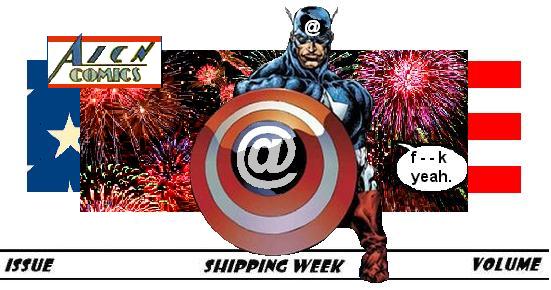
| #4 | 5/21/08 | #7 |
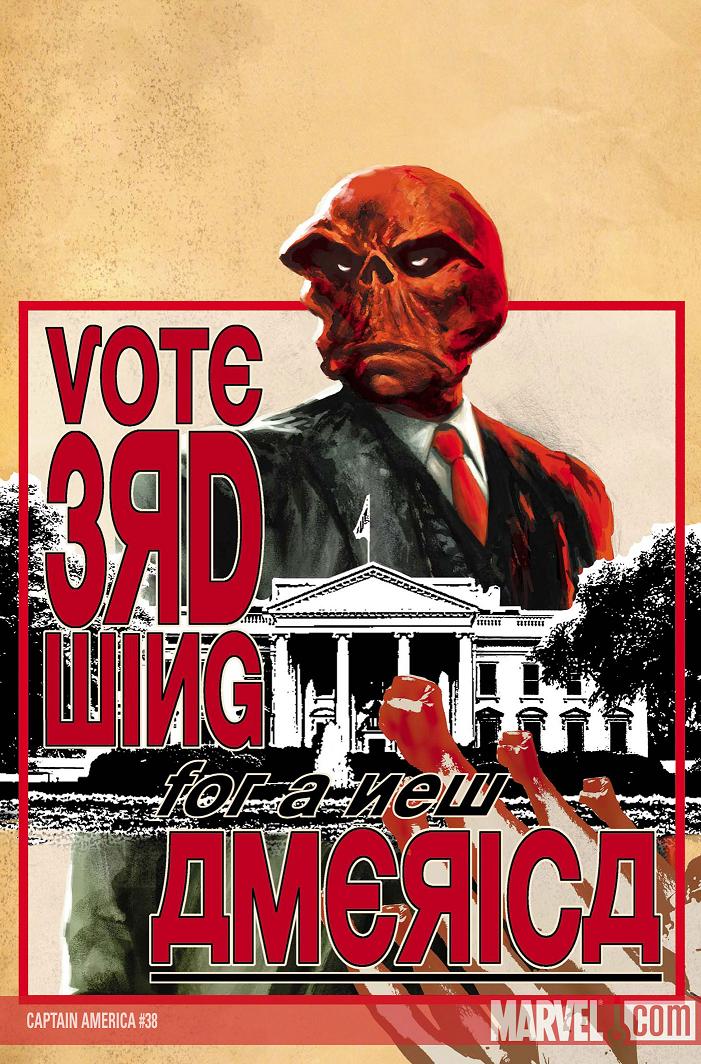
CAPTAIN AMERICA #38
Written by Ed Brubaker Art by Steve Epting Published by Marvel Comics Reviewed by Stones Throw
I haven’t checked in on CAPTAIN AMERICA for a while. Not because I haven’t been enjoying it, just that I kind of get turned off when everyone and their comic book loving brother is raving about it, and a few slow issues from Brubaker get me thinking that the ubiquitous internet coverage will keep me clued on what’s happening. I kind of like missing a few issues here and there, though. It gives me a different perspective on the whole thing and I feel that my appreciation is enhanced when I catch up after a month or two away.Because, make no mistake, this book is still the best book Marvel’s putting out right now, or at least the only one I’m reading regularly. I had some worries when that bullet hit in #25, but since then Brubaker’s kept up the momentum achieved by Cap’s death remarkably well. The reason this “event” has been more successful than Marvel’s other attempts at major changes recently is because it grew organically out of the saga Bru’s been constructing for a few years now. A lesser writer might have had the Living Legend lose the “Living” part at the end of his first arc on the book, but Cap’s assassination was the culmination of two years of solid Captain America stories (and a so-so three-part CIVIL WAR tie-in). If it felt jarring, definitely a quality of that landmark issue, that’s because assassination should feel jarring and unexpected. Especially when it comes to 80-year old WWII veterans in red, white and blue tights.
Coming to think of it, even Bucky wasn’t brought back for good until into Bru’s second storyline on the title. So what I’m getting at is the reason the major developments in CAP have worked and not thrown fans with the transparency of their motivations is because they’ve grown out of the story being told, and, most importantly, the characters. And so, in #38, when Steve Epting depicts the new Captain America (James Buchanan Barnes) riding on his motorcycle with the Falcon flying next to him, the sun setting behind them, it’s almost as if nothing could feel more natural.
In fact, I’m almost to the point of wondering if Steve Rogers will be returning. It certainly doesn’t look like Brubaker’s current story has any need for a resurrection. Rogers is a classic character, but also a man out of time (which was actually the title of Brubaker’s first storyline), and having Bucky turned the Winter Soldier turned back to Bucky become Captain America is a great new Marvel character and an easily sustainable series. I can even see the original Cap becoming sort of a talismanic figure to the rest of the Marvel U in his death, sort of like Barry Allen is at DC. Well, at least until now. Comic books, huh?
What about the current progressions in the book, you say? Well, it’s a brave man who brings clones into the mix. But the whole mind-wiping plot with Agent 13, Dr Faustus and the Grand Director is creepy enough to work. I also want to applaud the use of history in this issue, all of which is recounted in Steve Epting’s moody flashbacks. This is the best argument against all those nu-Marvel fans and boys who would have you believe continuity is a four-letter word and that any footnotes or references will cause an inexperienced reader’s head to explode with incomprehension. Here, the histories of the various characters are used to give the plot a whole other dimension and it’s all clearly and dramatically summarized. Well, there’s no footnotes, but let’s not get carried away here.
Since the privilege of being quoted on the cover of AMERICAN SPLENDOR (check it!) has gone to my head, I’d like to finish with similar pickings for the ad wizards at Marvel. CAPTAIN AMERICA: the fuckin’ dog’s bollocks. And you can put that on your trade paperback and smoke it.
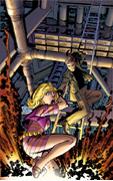
STAR TREK: ASSIGNMENT EARTH #1
Writer: John Byrne Artists: John Byrne Publisher: IDW Reviewer: Jinxo
Okay, the back story for the geek impaired: back in the original “Star Trek” series there was an episode called “Assignment: Earth”. Even though technically it’s a Trek episode, what it really was was a backdoor pilot for a new TV series. This kind of episode pops up in a lot of shows. The main characters still play a role but suddenly they become secondary to a whole knew cast of characters and the plot ends up being something almost entirely removed from the show’s normal plot. So you tune it to watch one show and get baited and switched into watching something else. And then if the show isn’t picked up that episode just ends up being this oddball anomaly.Well, “Assignment: Earth” was “Star Trek”’s oddball anomaly. For the thinnest of reasons the Enterprise travels into the past (they’re on a mission to monitor history). While there they discover an alien on Earth named Gary Seven, who may or may not be up to no good. Since he’d be the star of the new show I’m sure you can guess he ends up one of the good guys. Turns out he is on Earth to help subtly guide us through the dangers of technological advancement. In other words, he’s here to keep us from blowing ourselves up. He’s aided in his mission by cute but ditzy Earth girl Roberta Lincoln (played by Terri Garr), his cat Isis (who we learn can turn into a hot babe) and the requisite super computer. In the episode, Gary and the Trek crew do in fact stop us from blowing ourselves up. Well, at least part of the planet. In the end Kirk and company return to the future and leave Gary Seven to continue his mission. Only, really, that mission was about it.
I actually always wondered why Gary Seven wasn’t worked into Trek continuity in some meaningful way. Yeah, he was brought into play in some secondary Trek stories but I always wished they’d pull him into play again in one of the actual Trek series if just to justify that oddball episode’s existence. Give it a reason for being there.
Cut to three decades later and, finally, someone has decided to try and do something with “Assignment: Earth”. Okay, it’s in comic book form which is hardly canon, but still, I was kind of excited to see someone working Trek’s one and only dead end into something. And despite the premise being a failed pilot I could actually see where they could turn it into something fun. I mean, the writer has his own largely unexplored corner of Trek history to play in. It’s set in the 60’s so you could totally do something crazy retro and funky. I mean, I flash right back to those early 70’s comics with everybody wearing the huge collars and the flood pants, where anyone who was black had a giant afro and where every other character seemed intensely radical about one damn thing or another. That material is fertile ground to revisit both in a straight way and also more tongue in cheek. The right writer could potentially have a field day turning this sow’s ear into a silk purse.
And look who was brought on board to write it? John Byrne. He’s on board to both write and draw the book. Now I know some folks aren’t exactly Byrne fans anymore. But on paper this sounded like it could possibly be a good match. The man made his rep in comics back in close to the same era as this book is set, so a Byrne look to the book could work. And if he went and had a good time with the material…well, it might work.
It might. Really. I was actually hopeful. Then I opened the book and…it doesn’t. It’s just a damn shame of a misfire. I mean, it’s not horribly incompetently bad. It’s just…there. Instead of a story written by someone jazzed to take the premise and have some fun with it, it just feels really phoned in. Imagine if back in the day “Mission: Earth” had been picked up as a series and it became a just so-so sci-fi outing. And then some comic book company turned around and created a comic book version of the show that was only half as good and twice as cheesy as that. I think I would rather read an issue of that comic than this. That comic would probably at least have some goofy aged fun to it. The new “Assignment: Earth” is just…there. The first issue is just a by the book story that hits all the points it’s expected to without any attempt at much else. I kept reading just hoping for some spark of fun or joy to it, but…nothing. Once again Gary Seven is stopping a bomb from killing us all. He goes undercover as a scientist. Does he use a clever alias? Nope. He pretends to be Doctor Gary Seven. ?!??!? What could be stupider than not realizing that a number for a last name is sort of odd and conspicuous? Oh, I know. A whole bunch of top secret genius scientists who don’t find a man with a number for a last name suspicious. What would it take to make these people suspicious? “Hi, I’m Doctor Dick Fartknocker.” They wouldn’t bat an eye.
At about the halfway point I realized I was truly in trouble though. At that point Gary gets files on all the suspects in his investigation. I looked at the next page and it was a full page of pictures of all the suspects with a paragraph long biography of each and every one of them. I went beyond bored into despair. I thought, “Oh dear God. I’m supposed to read quick bios on nine characters almost all of whom are going to end up being utterly irrelevant to the story. Almost all this page is going to be a total waste of my time.” Seriously, I felt a little despair. Not what you want in a comic. It instantly became the comic I just could not not put down. Very rarely have I actively tried to push a comic away. I walked away. I went and saw a movie. I lived, dammit, I lived! I was happy. Then later…I came back and finished the book. After the bio page things actually picked up from despair inspiring and returned to just average.
Now, even with my reaction to this book, I would still like to actually hold out hope for it. It’s a fool’s hope, I know, but…I so want this book to be good. It’s just such an odd footnote in Trek and it would be fun to see someone make it work. Many might say that won’t happen with Byrne writing. And they might be right. But I so want to believe he can do it. Byrne, talking directly to you here. Go nuts. Go get crazy drunk or whatever it takes for you to get loose. Think up the craziest out there retro sixties sci-fi tale you can think of. Just go nuts and write a story so funky that you can’t help grinning like an idiot and write that bad boy down. Odds are if you’re having a blast with it so will we. I just can’t believe you entertained yourself writing this issue. I can’t. I like the art. I think it suits the period of the book. But you have to give us a story to get excited about, and this isn’t it.
Jinxo is Thom Holbrook, lifelong comic book reader, and the evil genius behind poobala.com. He may appear cute and cuddly but if encountered avoid eye contact and DO NOT attempt to feed.
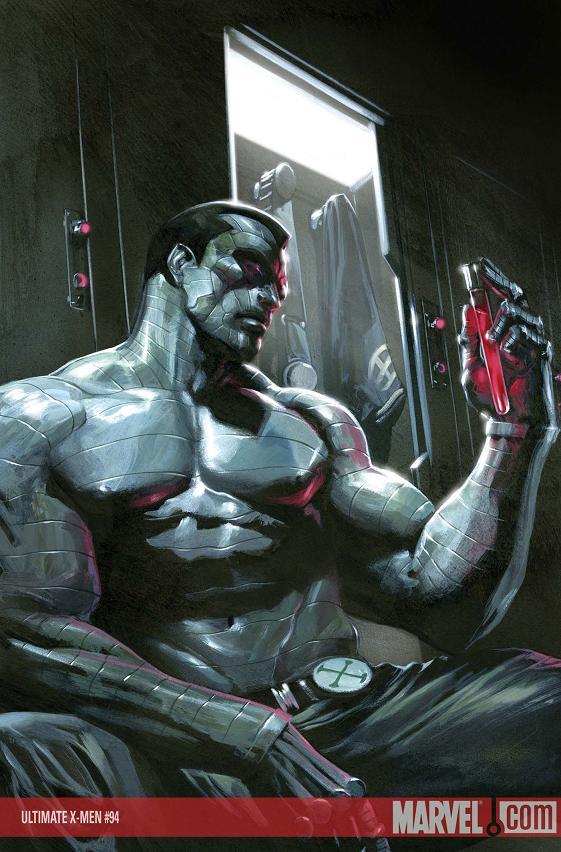
ULTIMATE X-MEN #94
Writer: Aron Coleite Artist: Mark Brooks Publisher: Marvel Comics Reviewer: Optimous Douche
“Heroes” scribe Aron Coleite pulled off two astounding feats with this book. He tackled societal issues that are generally fodder for Bill O’Reilly as opposed to the X-MEN. Plus, he found a way to make Peter Rasputin interesting apart from his demonic sister or in the context of schtupping Kitty Pride.Colossus has always bored me in UNCANNY and X-MEN. I understand every team needs a strong silent type to weigh the balance of the snarky smart-ass and the stoic leader, but based on past personality traits you would never get me to run out to buy a Colossus mini-series laden with panels of him smiling, pining for his sister, and painting.
Like most characters in the Ultimate Universe (especially the team based books), the original writers (cough, editors) updated each character with just the right amount of demographic cross-pollination to show that there was a little something for every comic reader within the Ultimate line. And that’s been part of the problem; all we’ve ever been given is a “little something”. All we’ve ever really known about Colossus is that he once worked for the mafia and he’s homosexual.
I’ve always questioned the moral fortitude of the Ultimate Colossus for making the decision to work for the Borscht Cosa Nostra. Finally after 93 issues we learn the reasons behind why this traditional “good guy” sold out to the mafia in the first place. I give Coleite credit for making the character a victim of circumstance as opposed to just a blatant opportunist. Ostracized by his family for being a “friend of Dorothy”, he is forced to survive on his own in post-communist Russia. Where most Russians survived the early 90s by learning HTML or starring in amateur porn, Colossus found his salvation by becoming a puppet of Russia’s underbelly. Stanislav Soprano further tightens his hold on Rasputin by hooking him on a power enhancing drug, without which Colossus would only turn to metal and be void of his Herculean strength, ostensibly making him a talking paper weight.
Of course when Jean Gray obtains this information through an invasive mind probe, the morality of whether to “juice or not to juice” becomes the central point of debate for the rest of the title. This blasé attitude towards invasive “peek-a-boos” into the subconscious also sets a new direction for how Jean Gray will leverage the Phoenix force in issues to come.
The best comic stories have always been the ones that tackle today’s societal pains without becoming preachy or delivering “Davey & Goliath” morality tales. Sometimes good people make bad choices and sometimes bad choices really aren’t bad at all, depending upon your perspective. Personally I could give a rat’s ass if baseball players inject themselves in the eyeballs with bull semen, as long as I can see humans perform inhuman activities. So naturally, I’m even less concerned if fictional characters decide to “juice” their powers. As we see at the end of this book, the X-Men are just as equally divided as America on the topic of “Better living through science.”
Oh yeah, the book also offers an appearance by Alpha Flight with surprise member Jubilee. I pray that Alpha Flight continues to be positioned as bad guys so I can at last see Wolverine’s mall rat gal pal Jubilation finally be eradicated from the pages of Marvel titles forever.
Brooks did a wonderful job keeping the artwork light and bouncy. With the heavy themes being discussed this book could have easily gone down a dark and morose path otherwise.
The morality lines have now been drawn. I’m damn excited for next month’s issue to see which X-men will fall on the side of angels, and which ones will not be able to resist the temptation of enhancing their powers.
When Optimous Douche isn’t reading comics and misspelling the names of 80’s icons, he “transforms” into a corporate communications guru. Optimous is looking for artistry help, critical feedback and a little industry insight to get his original book AVERAGE JOE up, up and on the shelves. What if the entire world had super powers? Find out in the blog section of Optimous’ MySpace page to see some preview pages and leave comments.
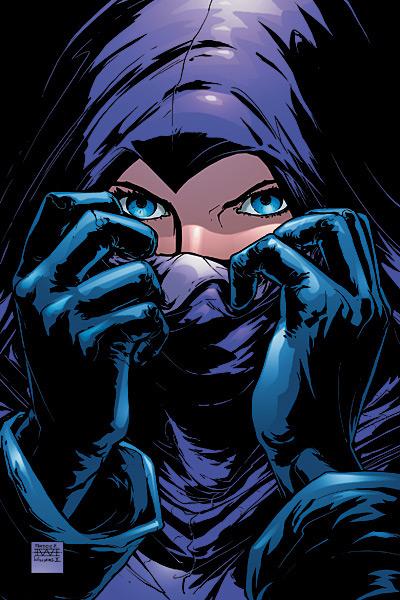
ROBIN #174
Writer: Chuck Dixon Art: Chris Batista (pencils), Cam Smith & Rick Ketcham (inks) Publisher: DC Comics Reviewer: Ambush Bug
Let me start off by letting you all know that I won't be putting any spoilers in this review. Well...the issue does focus on the Spoiler and who she is, but...you know what I mean. In this issue, we find out who the Spoiler is and...it's exactly who we thought it was.First things first, I don't want to complain too much about ROBIN because for the first time in years, it's actually readable. Seems Chuck Dixon is the only guy around able to make the adventures of Batman's sidekick better than just ho-hum. In fact, since Dixon's return a few issues ago, the book has been pumping along at a pretty impressive pace. Dixon keeps the action high and the teen drama present but not overly weighty. Towards the end of Dixon's run, ROBIN became somewhat weak when the teen angst became the central theme. But for a good 75 issues, Dixon wrote some of his best hard core action comics in ROBIN.
And this issue is pretty good. It starts out with a firefight between Robin, the mysterious new Spoiler, and new femme fatale Violet and the Korean Mafia. These opening scenes ooze with action with bullets and roundhouses flying from every corner of the page.
Then the book takes a weird turn. Batman is called in by Robin because he needs his "powers of persuasion." This job is to follow a well placed tracer and confront the new Spoiler in her lair. Batman shows up, the mask comes off, and it's time for the Spoiler to go into exposition overdrive. To me, there are a few things I have issue with here.
One of the points of giving Robin his own mag is to flesh out and distinguish him as a character apart from Batman. Now, I'm not saying that Robin wouldn't need Bats’ help from time to time, but in a tender situation where Robin is facing a character who may be impersonating the alter ego of his dead ex-girlfriend, you would think he would have what it takes to just do it himself without bringing in support. Batman just stands there anyway and doesn't even say anything. To me, this takes away from the character of Robin and it makes for a completely unnecessary cameo by the Dark Knight.
After the Spoiler mask comes off, man, does the exposition come on strong. Not only that, but it’s trusted sight unseen by both Robin and probably the most paranoid person in the DCU, Batman himself. At the end of the brief explanation of who the Spoiler is and why she is there, the Dynamic Duo simply shrugs and seems pretty ok with it. These pages reek with missed opportunity and writing that is surprising coming from a vet like Dixon.
In the end, Robin still has his suspicions, which is good. It looks as if the tale of the Spoiler is far from over and the revelation as to who she is is only the beginning. But I think that this story could have been handled in a much more dynamic and suspenseful way. It also could have played to Robin's strengths rather than having him run to Bats for an issue so close to his heart. Maybe it's a testament to how close Robin and Batman have become.
But again, this is the best ROBIN I've read in years. Chris Batista's art is extremely vivid and strong (although the profile of Robin in that last panel is somewhat off). And the story is pretty action packed. So I don't want to complain too much. One ineffective issue does not take anything away from that in my book. I just hope that the clunky aspects present in this issue are worked out in future issues and more of the strong action-oriented Dixon-helmed issues of ROBIN are on their way.
Ambush Bug is Mark L. Miller, reviewer and co-editor of AICN Comics for close to seven years. Look for his first published work in MUSCLES & FIGHTS 3 (AVAILABLE NOW!) from Cream City Comics.
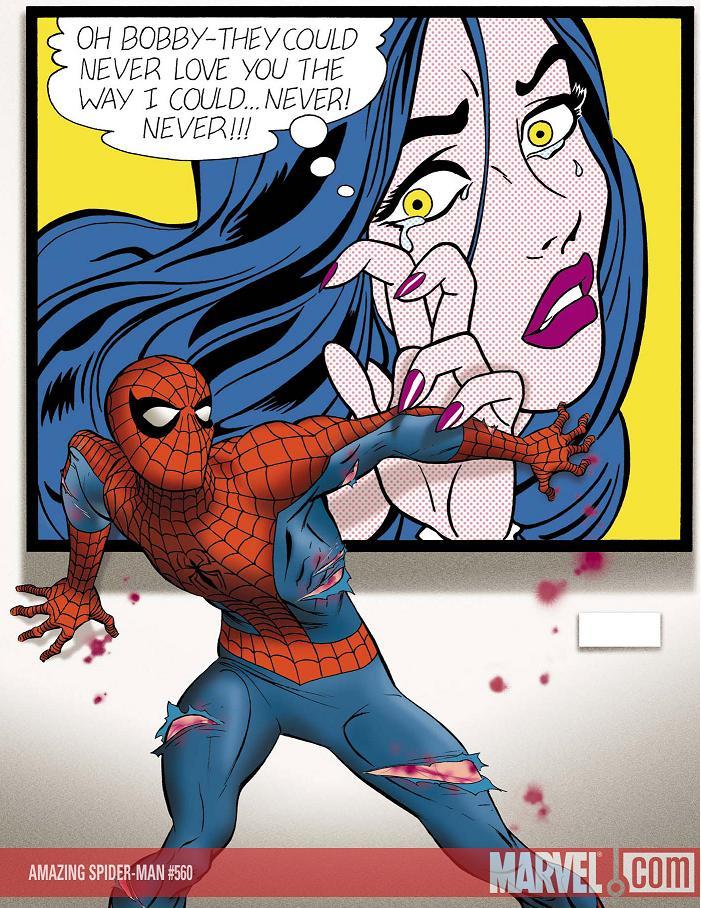
AMAZING SPIDER-MAN #560
Written by Dan Slott Art by Marcos Martin Published by Marvel Comics Reviewed by Stones Throw
I’m still pretty conflicted about this BRAND NEW DAY thing. I don’t know what more can be said about the ONE MORE DAY storyline that hasn’t already been yelled by every nerd with a broadband connection, but it isn’t looking any more logical or necessary four months in, and what with how they keep bringing up MJ as Pete’s ex and are already reintroducing her to the supporting cast, it’s even less clear why we couldn’t have had a divorce and thus missed out on the emotional insincerity that was BND’s weakest link. But there’s no denying that the new set-up’s begun to hit its stride with last month’s cool and creepy three-parter by Zeb Wells and Chris Bachalo and the equally excellent follow-up currently in progress. The quality of AMAZING is about as high as possible right now, but I’ve still got a few doubts that are more a matter of personal judgment. Some moral issues, if you will.But firstly, let me say every other issue of AMAZING SPIDER-MAN would be improved exponentially if Marcos Martin was drawing ‘em. Heck, he could draw every book on the stands and I’d be happy. Dan Slott is gelling a lot better with the guy than Steve McNiven, who, purdy pictures aside, I think might have been one of the reasons for the stilted feel of those first issues. Martin’s loose, jazzy cartooning just seems to fit a lot better with Slott’s script. He brings the same individuality he invested in Brian K. Vaughan’s superb Doctor Strange miniseries THE OATH while changing his style around considerably. His Spider-Man contains both Ditko and Romita and an alternative, European flavor that’s all his own, and the action scenes are dynamic and free-flowing as much as THE OATH’s were epic and portentous. The book really is gorgeous to read right now, and Martin’s art is more than enough to recommend it on its own merits.
Slott’s bringing a pretty decent story as well, though. We’ve got two cool new villains and finally something interesting for Peter Parker to do. The paparazzo story is timely and a good moral dilemma for Pete, and it distinguishes the differences between J. Jonah Jameson’s Bugle and the new owner’s effectively. Pete’s always scraped a living off misrepresenting Spider-Man; now he has to face the consequences of committing photographic libel against someone other than himself. It’s good all round, and Slott’s dialog has been refreshingly clear of the anachronistic baubles and corny in-jokes that marred his first issue on the title.
But I do feel they’re missing out on some tricks. Like the new owner of the Bugle. To my knowledge this is a new story for Spider-Man, so why make him so similar to Jonah? Forgetting Parker’s name, getting easily distracted, obsessive – seriously, he’s a flat-top, a cigar and a bad temper away from his predecessor, which perhaps is why I’m struggling to recall his name. These past two issues have explored the differences between the classic Bugle and the cynical, slick, celebrity-obsessed new one most clearly. Shouldn’t the publisher of a paper like that be younger, more calculating, smoother? Why another lovable old guy?
Same kind of thing with the actor Pete’s charged with stalking. If he was nastier, a little less justified in lashing out, we wouldn’t be so quick to recognize Pete making a mistake. But he’s never less than sympathetic. He’s also a very uninteresting fictional celebrity, a non-specific leading man who’s getting hassled by the press for unidentified reasons (no drugs, no lovechildren or 24-hour marriages mentioned. No nothing). I’m thinking of the English rock star in Alan Moore’s PROMETHEA as an incidental celebrity who was still a larger than life, amusing character who stuck out from the sidelines. Even a more direct parody of real life (say, a Britney Spears or Paris Hilton type) would have achieved the result of making a plot device of a character at least a little memorable.
I’m usually hesitant to point out what I would have done, but these examples seemed obvious and strange enough that I wondered why Slott, Wacker and co. didn’t pick up on ‘em. I think this can only be another case of the weird nostalgia thing they’ve got going on in BND. It’s been cropping up in the random, clunky use of thought balloons (which thankfully improved once Zeb Wells started) and overly broad subplots like the police quickly assuming Spidey’s a killer when some Spider-tracers show up on corpses, but now it’s become a reluctance to try slightly imaginative stuff in the incidental plotlines. I don’t know why the ret-con made three-quarters of the writers think it was 1969 again, but I do know Stan Lee tried a lot of whacked out stuff in his run on SPIDER-MAN. I think a few guys even call him a pioneer. And you don’t get to re-consecrate Stan’s Spider-Man days by aping what he or others might have done! Thankfully, this might be improving with stuff like Marcos Martin’s innovative page layouts, the hilarious scene with Jonah in the park and Wells’ cool breaking of the fourth wall and panel boundaries in his last issue.
But the “safe, nothing challenging” attitude provokes my biggest criticism of these past two issues. There’s an emotional core missing. Robbie Robertson’s less than enthusiastic with the direction the Bugle’s taking and is disappointed with Pete’s decision to start selling intrusive pics of celebrities. But we don’t see him get cold with Peter, or show anything less than his usual avuncular attitude. He doesn’t stand up to the new owner or walk out, which might’ve been a truly memorable plotline. Pete later tells Aunt May “you sound like Robbie” when she expresses disapproval of his new job, but we never saw what he might be referring to, which could have taken Pete and Robbie’s relationship in a new direction, given it another dimension. Too bad.
AMAZING SPIDER-MAN’s pretty much perfect as a 1960s/’70s revival right now. But why settle for that? Let’s see some classic Spidey stories here. Stories that add something to Peter Parker’s character, that give us something we haven’t seen before or could have come up with ourselves. You’re doing a good job, guys. Show a little ambition with your supporting casts and subplots and go out on the line a bit more and you might have people forgetting OMD ever happened.
Oh, and Grant Morrison did a superhero battle in a pop art gallery first. Like two years ago. Just sayin’.
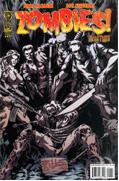
ZOMBIES!: HUNTERS #1
Writer: Dara Naraghi Art: Don Figueroa Publisher: IDW Reviewer: Ambush Bug
What is it about zombie comics that I like so much?I asked myself that question and it took me a while to come up with an answer. Readers of this column know that I have an unhealthy obsession with comics and films featuring the brain-craving undead. And now, with the release of IDW's latest ZOMBIES! miniseries, I get a chance to gab a bit and try to get to the root of this fixation.
Sure, zombie stories are ripe with subtext. Zombies have represented everything from mindless consumers (in DAWN OF THE DEAD) to the sheer apathetic nature of modern man (in SHAWN OF THE DEAD) and in comics, zombies can represent ourselves in this nation-wide, post-traumatic disordered, post-9/11 world we live in (THE WALKING DEAD). Sure, there are plenty of heady aspects to the genre; that could be the reason why they pique so much of my interest.
Such heady potential is one of the reasons I am addicted to this genre, sure, but I think my affinity for zombies comes from someplace more personal to me--a reoccurring dream I have had since childhood. In just about every zombie movie, after the realization that the zombies exist and the group of survivors have holed up and that shelter has proven to be useless against the rising undead masses, there's always a scene where the group is running away from the zombies and no matter how many bullets or how fast they run, the survivors are often faced with a mass of decayed flesh and outstretched arms eager to feast on them. They keep coming and nothing can stop them. I've had this exact scene play out in my dreams for years. It's made me shoot straight out of bed many a night. I run and try to escape, but the zombies are right behind me. There are scores of them. And they want to eat my brains.
Now, I know a psychiatrist would have a field day with that one. And who's to say that he or she wouldn't be correct that these zombies represent life stressors or the past coming back to haunt me or whatever. But to me, that image is so engrained in my mind through many nightmares that I find myself drawn to that type of fiction over and over. Maybe, in some way, I am therapeutically embracing this fear as a means to overcome it. You tell me, Freud.
Having embraced just about everything and anything with zombies in it, one might call me somewhat of a connoisseur on the subject of it. I've sat through zombie movies ranging from awful to awesome, read middling zombie books and comics, and written my own zombie yarns from time to time. So when I see a comic like ZOMBIES!: HUNTERS on the shelves, I usually don't think twice about picking it up and giving it a look-see.
Problem is that zombie comics (and films for that matter) have hit kind of a rut that dates all the way back to George Romero's original NIGHT OF THE LIVING DEAD. I don't know how many times I've had to read or see the beginnings of the zombie plague. The initial reactions of the cast and the setting of the rules of the genre (shooting in the head, can the zombies run or walk, was the zombie armageddon caused by voodoo or a comet or has the cause gone completely unexplained) are usually the framework which a zombie story is hung upon. So much of so many zombie comics/stories/movies are dedicated to the initial outbreak and so little looks at what happens after that.
That's why ZOMBIES!: HUNTERS is so fun. This isn't an initial reaction story. The characters in this book know zombies exist, they know the dangers; in fact, they embrace these dangers. Written pretty tightly by Dara Naraghi, HUNTERS is a MOST DANGEROUS GAME-type tale where the hunters and the hunted are man and zombie. A group of bored richies pay big money to go to an island and hunt zombies. A crusty group of ex-militaries run the island and a houngan witch doctor resurrects the dead in order for the game to be played. I have to admire this book simply for the fact that it breaks the zombie mold and starts after the initial outbreak begins. Zombies are a fact and everyone in the story knows it. This provides a different type of tale and a different type of tension and suspense. Coming from someone who has read his fair share of zombie lore, it's a welcome change.
In addition to a fun script and plot, the art by Don Figueroa is nice and moody. The panels are heavy on shadow and Figueroa is highly confident with the blood splatter. The artist does a good job bringing variation to the panels and what's in them. Close-ups and wide angle shots are both done with high artistry. Simply put, this is a good looking book.
At times, some of the humor is sophomoric and falls flat (but I think the characters saying these things are supposed to be somewhat moronic), but I found the premise of this book to be refreshing to read given the stale crypt-like smell that permeates the current zombie fare. If you're a fan of zombie fic, this is one you shouldn't miss. Part-time horror fans will probably enjoy it too. ZOMBIES!: HUNTERS #1 proves that there are still new and exciting ways to tell a zombie story.
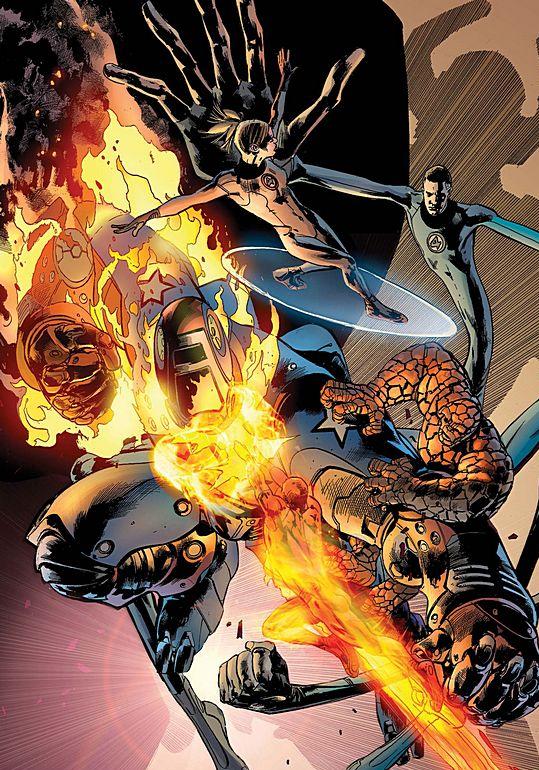
FANTASTIC FOUR #557
Writers: Mark Millar and Bryan Hitch Inkers: Bryan Hitch and Andrew Currie Publisher: Marvel Comics Reviewer: Jinxo
Is it possible for a comic book to be smug? Because to me this comic just exudes smug. Undeserved smugness. I guess I’m supposed to love this book because Millar has taken the reins. And I have liked his work in the past. So throughout this first story arc I have really wanted to like Millar’s FF. But I just don’t. It’s not an utter disaster but it doesn’t blow my doors off either.Supposedly with this run on the book the FF are going to be getting back to the original roots of what makes the Fantastic Four the Fantastic Four, and I’m all for that. But I walk away from this book feeling they’ve interpreted that concept in entirely the wrong way. Here’s a bad sign: this issue made me flash back to an interview I saw with the makers of “Melrose Place”. They stated that for the show to work the characters could really never be allowed to learn from their actions, from their past mistakes. If they did they would know better than to continue to get into the same sort of messes the show thrived on. I feel like that’s the sort of way the FF has gone back to its roots, by having their characters forget any growth they’ve experienced since day one. For instance, I buy that Johnny Storm from the start of the FF might be willing to fall into a relationship with a pretty thief. I even believe that the Johnny Storm of today could temporarily ignore a hot thief’s occupation in the name of lust as long as he wasn’t confronted with it directly. But in this issue it is put right in his face, and the idea he would still continue that relationship…I just don’t buy it. Because, again, this isn’t Johnny from decades ago, a guy who only thinks about himself. He knows he represents not just himself but the whole FF. He’d know what sort of shit storm a relationship like this could cause for them. He’s also an uncle to two little kids he actually cares about. I don’t buy him not thinking of them, not even when faced with a crazy hot girl. There are just so many ways this rings false to me. But obviously Millar and Hitch want us to think of this as edgy and cool. I don’t. Again, just seems smug.
Then there’s the plot. For all the fancy sci-fi set dressing about building a new planet, this story is actually constructed of some of the oldest been-there-done-that plot elements I’ve ever seen. A giant man made menace accidentally unleashed on the Earth. If new life was breathed into I’d be all for it, but I don’t see anything new here. Painting it red, white and blue is supposed to make it new and clever. Try again. And how the menace is defeated? Please. Could there be an older gimmick? And, again, without anything new added to the mix. But clearly this comic thinks its plot is amazingly cool. Smug &%$&.
The topper for me is actually a very small moment at the very end of the book. Without spoiling specific plot points (although stop reading if you fear anything close to a spoiler), towards the end of the book there is a quick bit of time travel. The reason behind it is okay, but it finds Reed in the past prior to the creation of the Fantastic Four at a time where, really, there weren’t tons of heroes running all over the place. Look back to the first issue of FANTASTIC FOUR. When one of the group uses their powers in public for the first time people lose their freaking minds. Yet in this scene set in a pre-heroes era, Reed is out in a very public place and for no useful reason uses his powers. Just stretches for no good reason. It’s a small thing, but it made me crazy. For a book supposedly all about great writing and giving us great versions of these characters, why would it depict the team’s brainiac doing something utterly stupid for no good reason? He’s even in a situation where being low key would be a very good idea. But, nah, stretch out, freak out some people so they might start screaming in horror. I guess I should just ignore that because of the book is just so generally brilliant. Only it’s not. It’s smug.
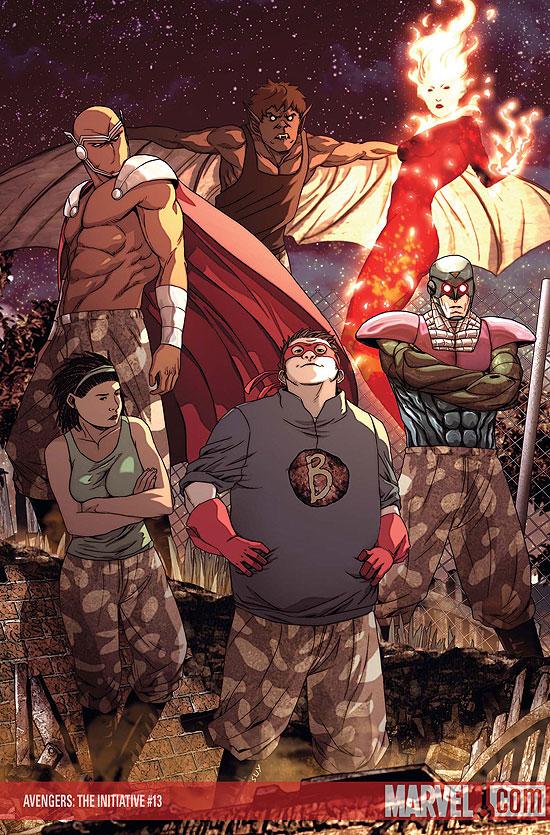
AVENGERS: THE INITIATIVE #13
Writer: Christos Gage Artist: Steve Uy Publisher: Marvel Comics Reviewer: Ambush Bug
I need to get something off of my chest, folks, and take advantage of this forum the @$$holes have made for themselves here at AICN. Occasionally, I get worked up over some aspect of comic bookdom and by god, I'm going to take this opportunity to bring it to light. It is an important issue--one where a discussion in a public forum is long overdue.I'm talking about Yellowjacket's dinky short-pants.
This major INITIATIVE player, one with a history in comics as long as my arm, has been traipsing around with his black undies over his yellow pants for way too long now. I understand it is a classic costume. I understand the respect for that. But tiny adjustments have been made to just about every popular character out there to update their costumes to make them more appealing to the eye. Characters like Thor and Captain America have been given slight costume updates with little or no complaint from the fans. Hell, Iron Man changes his armor every three months. Is it too much to ask the artists at THE INITIATIVE to draw the hero with some solid black pants?
They're stylish. They'd communicate power and tell anyone around that "Hey, I'm a hero, but I also mean business and dress accordingly." Yellowjacket has become somewhat of a one-note joke recently (a couple note joke is more like it). The character has been slammed for beating his wife. He's been put down for taking part in the creation of the Thor clone that killed Black Goliath. Hell, he may even be a Skrull. But I don't think that's the reason he's not more popular than he is.
I think it has to do with his tiny black pants.
Imagine, right now, your boss or your teacher walking into your office or classroom and barking orders to you in a black thong. How much respect are you going to have for that type of person? The answer: None.
I don't mean to harp on this subject, but just as I was getting into this comic, Yellowjacket struts in leaving nothing to the imagination when it comes to his bathing suit area. Marvel, heed my words, give Yellowjacket some decent pants!
Now, the rest of this issue? Top tits, my friends.
When I saw THE INITIATIVE in my pull this week, I was literally shocked. After last issue’s graduation of the cast members, I thought it was the final issue of the series. Plot threads were wrapped up pretty nicely and if it was a last issue, as far as last issues go, it was a damn satisfying one.
But it looks like this issue starts off with a whole new class of Initiative trainees. We open with a bus ride into Camp Hammond and are introduced to a handful of new recruits. Some of them are recognizable. Others I was vaguely familiar with. And some I didn't know at all. But it didn't matter. Writer Christos Gage introduces each class member smartly and incorporates just enough character to make me as interested in the characters. I wasn't a big fan of a lot of the last group of trainees. Hardball and Komodo? Ehh. Cloud 9 and MVP were cool. The Scarlet Spiders, awesome. But Dragon King? Trauma? Thor Girl?
I like this new crew. Some old Spidey characters (Annex & Prodigy) show up. I swear I've seen Gorilla Girl before, but I may be mistaken. It's nice to see Batwing from the old UNTOLD TALES OF SPIDER-MAN. And I think Boulder and Sunstreak are brand new. Gage does a good job of setting up a nice situation with the Taskmaster having a hit on his head and the new recruits being caught in the middle. It's a simple story, but a strong one nevertheless. It was a story that gives me confidence that, even though Dan Slott has stepped back to co-writing this book (giving him more time to write the increasingly good AMAZING SPIDER-MAN title), Gage is a worthy successor should he ever leave for good. The story focuses on Boulder, but gives everyone enough spot-on character moments to let readers know the book is in good hands.
Steve Uy's art took me some time to get used to, but I think it's going to grow on me. It's definitely along the same lines as work one would typically see in a RUNAWAYS comic. Manga-ish. Cartoonish. Simplistic and looking as if it were swiped from an animation cell rather than a drawing board. But given the youthful actions and characters in this book, it fits.
So it looks like we're in store for another fun-filled year with the Initiative. I'm glad last issue wasn't the last. Hopefully this new crew will be just as entertaining to read about as the last and I'm hoping this isn't the last we see of Boulder. He seems like a character worthy of more than just one story.
Now, if they can just do something about Yellowjacket's tightie-blackies, I'd be a happy camper. The solution is simple. Give Yellowjacket some long black pants, fer chrissakes! Talkbackers speak out loud and proud on this issue so the powers that be can give Yellowjacket back his dignity.
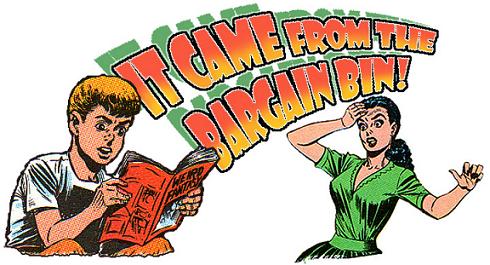
Every comic shop has them… battered long boxes jam-packed with dog-eared titles ranging from forgotten heroes of the 1970s to multiple copies of chromium-covered “collector’s item” comics from the Big Bust of the 1990s. But if you are patient, and dig deep enough, you just may find something special…
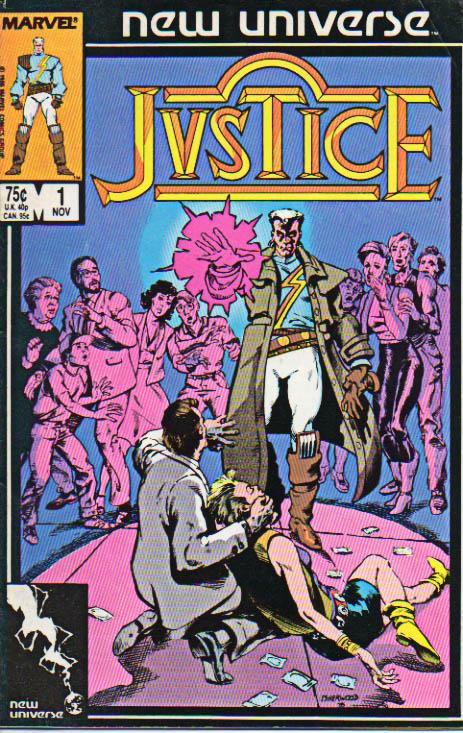
THE NEW UNIVERSE Part 2: JUSTICE
Published by: Marvel 32 Issues Total $$$ Spent: $11.00 Reviewed by: BottleImp
Having been intrigued by the Justice cameo in the pages of NIGHTMASK, this series culled from the depths of an extensive “three-for-a-dollar” bargain bin at a tiny shop called “The Cave” became my next foray into Marvel’s New Universe. JUSTICE is the story of Tensen, a “justice-warrior” from the alien dimension of the Glade of Spring, who is mysteriously transported to Earth by the White Event. Though Tensen’s memory is fractured and disjointed, he remembers enough about his purpose: he is able to see people’s auras and determine whether they are good or evil, and then pronounce “judgement”—either by slaying evildoers with the energy sword of his right hand, or protecting the innocent with shields projected from his left. As the first issues progress we learn that the enemies of the King of Spring, the Wizards of the Winterlands, have also found a way to cross over to our world. Their leader Darquill (aka “Dad”) and his son Damon Conquest attempt to kill Justice as he travels from New York to Los Angeles in search of answers to his lost life. Tensen is aided by Becky Chambers, a Federal agent whose pure aura has become “mingled” with Tensen’s own, thus giving them a deep psychic connection. Tragically, in a confrontation with Darquill in issue #5, Becky is stolen away from Justice and transported to the Winterlands, where her aura is reshaped into one of evil.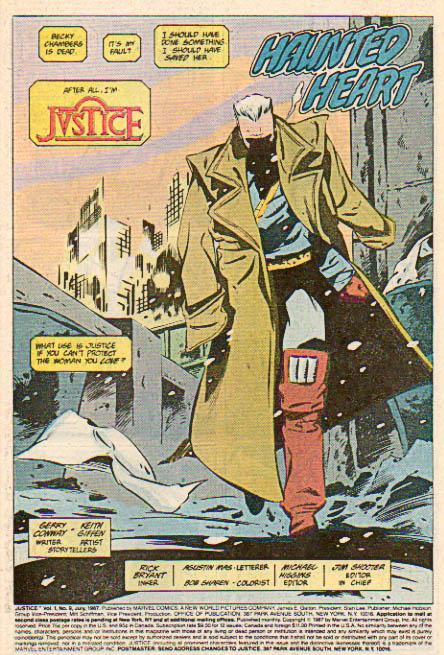 If all this stuff about “the King of Spring” and “Winter Wizards” sounds a little hokey to you, don’t worry—you’re not alone. Seeing as how the New Universe was meant to be a step closer to a more real-world comic book universe, JUSTICE seems fully entrenched in the standard alternate-world alien-monster kind of comic book storyline that was typical of the “mainstream” Marvel universe. Attempts were made to have Justice tackle the more everyday evils of drug dealing and gang violence, but these instances were merely fill-in issues as sidelines to the central plot (and frankly, they were usually the low point of the series both in terms of writing and artistic quality). And looking back on Justice’s character design some 20 years later one sees the personification of terrible ‘80s tastes: a baby-blue shirt, white pants, knee-high boots, trenchcoat, and a white power-mullet. He even sported Cyclops-esque sunglasses (taken from the remains of a “judged” drug addict) for the first issue.
If all this stuff about “the King of Spring” and “Winter Wizards” sounds a little hokey to you, don’t worry—you’re not alone. Seeing as how the New Universe was meant to be a step closer to a more real-world comic book universe, JUSTICE seems fully entrenched in the standard alternate-world alien-monster kind of comic book storyline that was typical of the “mainstream” Marvel universe. Attempts were made to have Justice tackle the more everyday evils of drug dealing and gang violence, but these instances were merely fill-in issues as sidelines to the central plot (and frankly, they were usually the low point of the series both in terms of writing and artistic quality). And looking back on Justice’s character design some 20 years later one sees the personification of terrible ‘80s tastes: a baby-blue shirt, white pants, knee-high boots, trenchcoat, and a white power-mullet. He even sported Cyclops-esque sunglasses (taken from the remains of a “judged” drug addict) for the first issue.As JUSTICE continued, the focus of the storyline became slightly more interesting. In his confrontation with Justice in issue #5, Darquill reveals that the Earth has a contaminating effect on people from their dimension, and that this “sickness” was being channeled back to the Winterlands in order to give them power to destroy the Glade of Spring. Darquill also implies that Tensen himself has become infected and can no longer “judge” purely. This notion of Tensen’s tainted aura became the focus of the series when Gerry Conway took over writing duties with issue #9. Aided by Keith Giffen’s dark artwork, JUSTICE became more internal and engaging—Tensen began to doubt his purpose in judging evil and the Winterlands went from being drawn as a background in the old Filmation “He-Man” cartoon to a grim, blasted landscape blending bizarre technology with medieval architecture. But then, just as the series was finally getting a good handle on its premise, everything changed.
 I guess it’s possible that this was always how the series was meant to play out, but it seems much more likely that the editors at Marvel realized how out of place JUSTICE was within their stated parameters for the New Universe. The White Event that sparked the paranormal abilities featured in the other titles had little in common with the White Event that brought Justice to Earth. And so with issue #15 Peter David came on board as writer, and the series made a sharp turn. With the aid of Nightmask, it is revealed that the Glade of Spring, the Winterlands, and Tensen’s mission as a Justice-Warrior are all part of a waking dream of the real-life Darquill. Tensen is in reality John Tensen, a narcotics cop whose powers from the White Event manifested when he became sucked into Darquill’s dream-world and subsequently lost his memory. Darquill is killed, the dream-world vanishes (as does Justice’s silly outfit and rockin’ mullet), and the remainder of the series followed David’s new take on Justice as a man believing he has been given power by God to punish paranormals who misuse their powers as Darquill did. A new supporting cast was introduced, featuring other paranormals who worked for the National Security Council, an “anti-Justice” named Seraph, and John Tensen’s daughter Angela. The artwork was also brought to a higher level when Lee Weeks became the regular artist on the series (although Justice’s new costume, a dark purple muscle-shirt emblazoned with a white lightning bolt, was only slightly less goofy than his original outfit).
I guess it’s possible that this was always how the series was meant to play out, but it seems much more likely that the editors at Marvel realized how out of place JUSTICE was within their stated parameters for the New Universe. The White Event that sparked the paranormal abilities featured in the other titles had little in common with the White Event that brought Justice to Earth. And so with issue #15 Peter David came on board as writer, and the series made a sharp turn. With the aid of Nightmask, it is revealed that the Glade of Spring, the Winterlands, and Tensen’s mission as a Justice-Warrior are all part of a waking dream of the real-life Darquill. Tensen is in reality John Tensen, a narcotics cop whose powers from the White Event manifested when he became sucked into Darquill’s dream-world and subsequently lost his memory. Darquill is killed, the dream-world vanishes (as does Justice’s silly outfit and rockin’ mullet), and the remainder of the series followed David’s new take on Justice as a man believing he has been given power by God to punish paranormals who misuse their powers as Darquill did. A new supporting cast was introduced, featuring other paranormals who worked for the National Security Council, an “anti-Justice” named Seraph, and John Tensen’s daughter Angela. The artwork was also brought to a higher level when Lee Weeks became the regular artist on the series (although Justice’s new costume, a dark purple muscle-shirt emblazoned with a white lightning bolt, was only slightly less goofy than his original outfit). Flawed, yes—much like NIGHTMASK, especially in the early issues. The fill-in stories took away from the central plot (usually these issues were written by a completely different writer, which made the series feel even more fragmented) and the artwork on the whole was pretty uninspired. However, unlike NIGHTMASK, JUSTICE managed to be more interesting due to having an ongoing plotline rather than an episodic format. With the later addition of the creative team of David and Weeks, JUSTICE grew into a comic that focused more on the nature of good and evil, and became a more thought-provoking and engaging read. Unfortunately the series ended not with a bang but a whimper (“#32 in a Thirty-Two Issue Limited Series,” the cover blurb wryly proclaimed) as the New Universe slowly collapsed in on itself, leaving piles of comics destined for the bargain bins and a few good ideas left for later writers and artists to explore. An inevitable confrontation between Justice and Starbrand which had been building steam from issue #18 never materialized (more on that in the next New Universe installment of this column), and JUSTICE was brought to a subdued, only halfway-satisfying close.
Flawed, yes—much like NIGHTMASK, especially in the early issues. The fill-in stories took away from the central plot (usually these issues were written by a completely different writer, which made the series feel even more fragmented) and the artwork on the whole was pretty uninspired. However, unlike NIGHTMASK, JUSTICE managed to be more interesting due to having an ongoing plotline rather than an episodic format. With the later addition of the creative team of David and Weeks, JUSTICE grew into a comic that focused more on the nature of good and evil, and became a more thought-provoking and engaging read. Unfortunately the series ended not with a bang but a whimper (“#32 in a Thirty-Two Issue Limited Series,” the cover blurb wryly proclaimed) as the New Universe slowly collapsed in on itself, leaving piles of comics destined for the bargain bins and a few good ideas left for later writers and artists to explore. An inevitable confrontation between Justice and Starbrand which had been building steam from issue #18 never materialized (more on that in the next New Universe installment of this column), and JUSTICE was brought to a subdued, only halfway-satisfying close.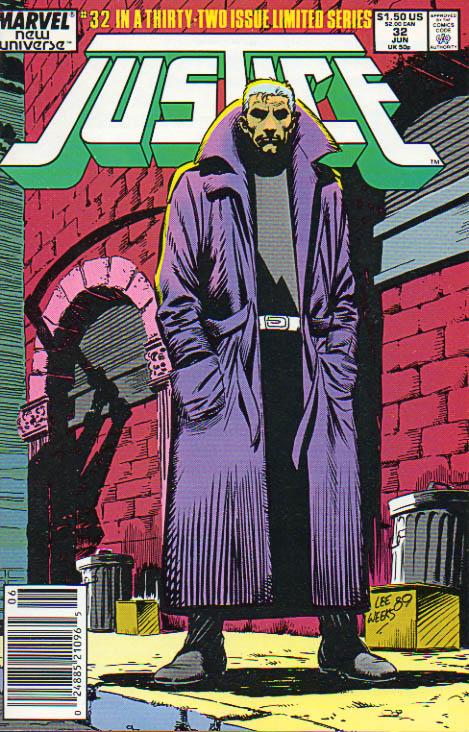 The majority of this series is worth a look, but here are some of the key issues:
The majority of this series is worth a look, but here are some of the key issues:#1-5: Tensen’s arrival on Earth through to Becky Chambers’ kidnapping to the Winterlands. #7-8: the main storylines are pretty bad, but there are cut-away scenes showing Becky becoming indoctrinated to Darquill’s regime, which becomes important later on. #9-11, #13: Conway and Giffen’s more interesting interpretation of the character. #15-32: Peter David and Lee Weeks bring JUSTICE more in line with the rest of the New Universe titles. All of these issues make for a pretty good read.
Next time in the Bargain Bin we’ll be looking at STARBRAND, which can be considered the fountainhead of the New Universe.
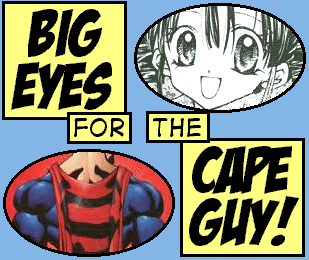

RAL GRAD VOL 1
Story: Tsuneo Takano Art: Takeshi Obata Released by VIZ Media Reviewer: Scott Green
BLUE DRAGON: RAL GRAD's Japanese, serialized publication took place in WEEKLY SHONEN JUMP, the famous home of boy's adventure DRAGON BALL, BLEACH, NARUTO, ONE PIECE, and so on. For its North American release, Viz put the series under their slightly older audience, "Shonen Jump Advanced" banner, with a "Mature Content" parental advisory. There are three key qualities of RAL GRAD. The first is gorgeous illustration by Takeshi Obata, of HIKARU NO GO and DEATH NOTE. The second is a tie into the BLUE DRAGON XBOX 360 fantasy RPG (though Obata's work offers a stark contrast to the Akira Toriyama designed characters of the game). The third is why the manga is rated "for older teens", and boasts the parental advisory. Its story is structured around justifying q protagonist's horny, angry, teenage behavior. He's a persecuted savior, who gets to lash out against the world, act unsocialized and grab breasts. This character stands as humanity's protection against a shadow queen who chains up naked women to suck their souls, when she's not lounging around in lingerie munching on deserts. Packed with nipple-free, sexualized, but not sexual nudity, RAL GRAD might not be quite as philosophically pandering as some relationship comedy manga, but it is intent on giving the teenage male reader what they want.Those familiar with the game might notice links between game and manga, but RAL GRAD is sufficiently distinct as a side story to the BLUE DRAGON game, that familiarity is not required. Its castles and knights medieval world is defined by a war that has united humanity against invaders from a dimension of shadows. Taxonomy is a significant, frequently reiterated aspect of this conflict. The shadows in their first form are "parasitics", which can manifest their own shape from the shadow of their host, provided that they have permission. The "predator" second form consumes the flesh and spirit of its host, allowing the shadow to assume its own physical form or that of its former host. The third, "transformative" form can assume the form of any creature it devours. Then, there are special individuals who maintain their free will after being lined to shadows...
After Ral's mother died giving birth to the boy, a titanic dragon manifested itself from the newborn's shadow and begun setting nearby mountains on fire. The powers-that-be reacted by locking the boy in a pitch black container to ensure that his shadow could not manifest itself again.
In the intervening 15 years, Ral's only contacts were his dragon/shadow Grad, and his tutor Mio. Given that the manga is as much about ogling as it is about action, Mio's significant characteristics are that she's a very shapely, very chesty, bespectacled young woman. With the shadow attacks on humanity reaching a critical momentum, Mio is given permission to set Ral free, where upon this wild haired boy, who had been locked away for his whole life, gives the knight who imprisoned him a brutal payback punch, rips off Mio's clothes and feels her up, then sets about dispatching a horde of attacking shadows.
The premise of spending 15 formative years in sensory deprivation, only hearing from a saintly woman and an other-dimensional dragon, whose interests might not be aligned with that of the human race, could yield some fascinating speculative sociology. But, here, imprisonment since birth is an explanation and a justification for why Ral has the opportunity to act and see himself how the target demographic of the manga might wish to act and see themselves. The burden of super powers as long been the stock and trade of super-hero comics and many threads of shonen manga, but, with young women either stripping down and throwing themselves at Ral or at least being good natured about his obsession with their bodies, RAL GRAD is vicarious wish fulfillment of a high order. That the carte blanche for Ral's actions is that he's protecting people, and that in particular he's driven by a possessive urge to protect woman, does not have the nicest historical parallels. If there are saving graces, they present themselves in that the fantasy world distances the manga from reality and that ultimately, the manga does not take itself too seriously. Where the familiar story of the average young man suddenly finding that he's special and getting all the girls might lead to some gross pandering in manga, RAL GRAD's ground-up justification does succeed in smoothing out a few of the irritating bits of the premise.
While Mio is great eye-candy, with a bit of a good girl version of G.I JOE's Baroness going on, the series could really benefit from an honestly assertive female foil to Ral. So far, in addition to Mio, Ral's travelling companions include Aia, a kittenish 13 year-old with a lolling tongued lizard for a shadow, and Kafka, a chivalric teen knight who plays the part of the frustrated rule-following straight man. The manga only runs four volumes in total, and it can sustain that length on action, without enhancing the character dynamics, but the steps to ensure that no one overshadows Ral serve as another reason why the manga is not swimming in depth.
RAL GRAD demonstrates Obata's hand for intricacies and eye for fitting complex images together. Each page is crowded. Backdrops are full, either with speedlines or detailed backgrounds, with far less void space than most manga. The foreground is similarly dense with characters decked out in bold costumes in the tradition of games like FINAL FANTASY. If you handed the book to someone who isn't a comic/manga reader, it might be too much, but for someone who is familiar with the medium, Obata's composition is such that the work is an easy, energetic read.
Fans of DEATH NOTE will not be disappointed to see the results of Obata translating his style to a fantasy setting. As his underworld scenes and iconography-heavy color illustrations of DEATH NOTE indicated, despite making a name in manga that had a least one foot planted in the concrete, real world, he does have an eye for imagined landscapes. Scenes such as a WIZARD OF OZ-like field of flowers, towers covered in giant rose vines, and the cave with the cocoon like orb that imprisoned Ral all benefit from Obata's tight, detailed approach.
If, through age or disposition, you aren't put off by a hero who introduces himself "'Ral, the Squeezer of Tit'-- I mean 'Ral, Savior of the World'!" then RAL GRAD falls into the range of interesting curiosities within the spectrum of fantasy stories. Obata's illustration and the concept for the shadows are enough to carry the world through its four volume run. Any longer, and its bypassing of the deeper potential of Ral's circumstances would have become too problematic.
Scott Green has been writing for AICN ANIME for close to seven years. If you like what you see here and love anime & manga, be sure to check out his latest AICN ANIME column here.

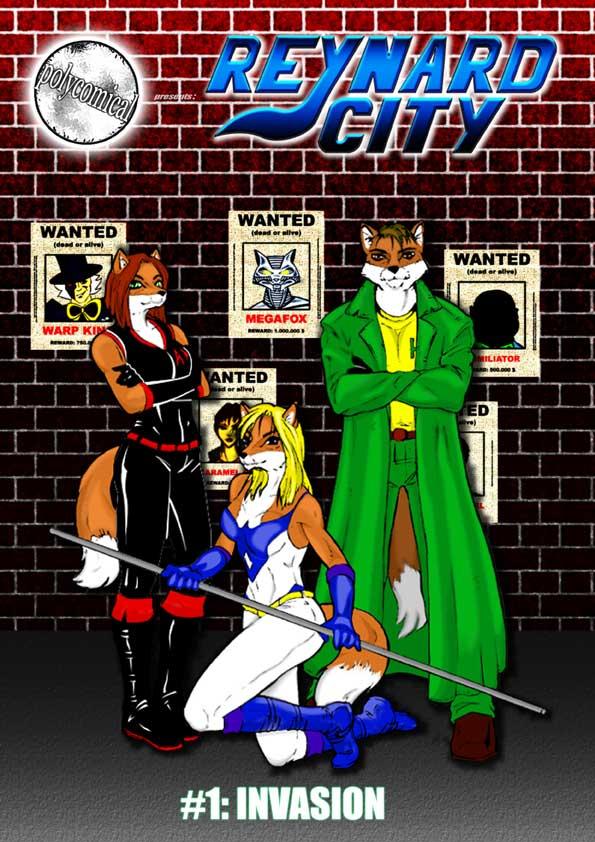
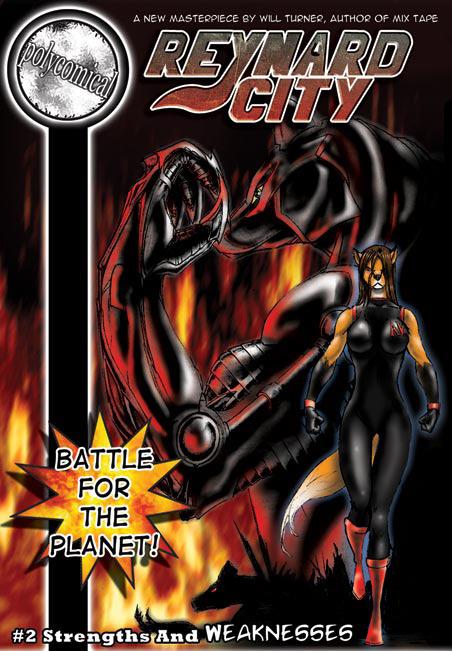
REYNARD CITY #1-3 Polycomical
I had a chance to look at the first three issues of this series and it looks to be the beginning of something big. The story leaps right out of the gate into a giant battle between anamorphic warrior people and a robot-animal army. The narrative then hops back a few hours to see how this battle came to be. This is a nice set of books by writers Will Turner and Sabastian Rigler and art by Ubod Ng Lumpia, Dan Butcher, and Jace Mareel. It’s kind of fun to see these animal characters walking upright and acting like humans. Some of them have superpowers. All of them have attitude. The story takes some decent twists and turns throughout the three issues. The main hero is a female named Vibes who announces her superpowers before using them. The banter between the bad guys is fun too. The art is pretty good, although somewhat stiff occasionally. But the guys doing the visuals try to give the panels a lot of angle and flair. All in all this is a nice example of some talented people who are just starting out in the comics biz. If you want to see some budding stars, you should check out REYNARD CITY. It looks to be something cool. – Ambush Bug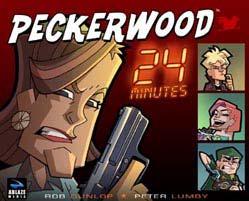
PECKERWOOD: 24 MINUTES OGN Ablaze Media
This comical farce on the 24 TV series casts the TOZZER crew of wannabe actors and filmmakers as the center of the action. The book has a lot of fun with the clichés that the TV series is riddled with. Kiefer Sutherland is the butt of many jokes as the overly serious spy tries to squeeze in more action than what is chronologically possible within the 24 minute time frame. Writer Rob Dunlop has a lot of fun with time in this book with some clever beat panels, and artist Peter Lumby has a strong design sense, making his characters individually unique while recognizable in numerous disguises. I had a lot of fun reading this book and recommend it to followers of the TV series 24, as well as those who like a good laugh. – Ambush Bug
